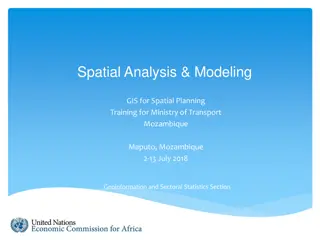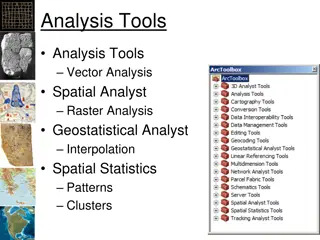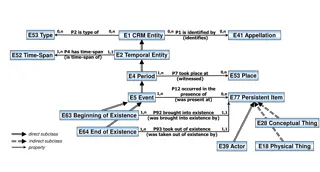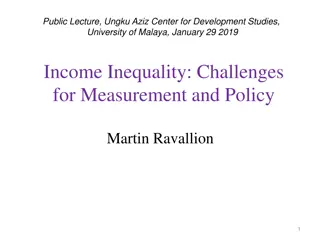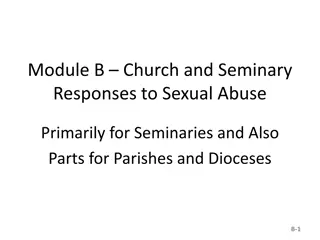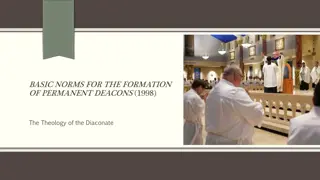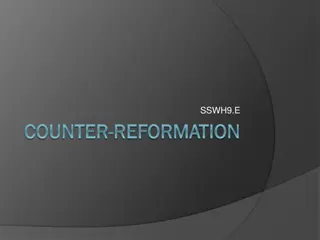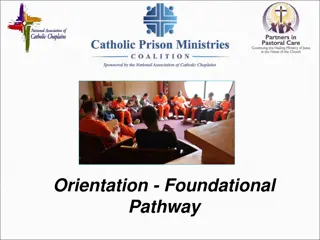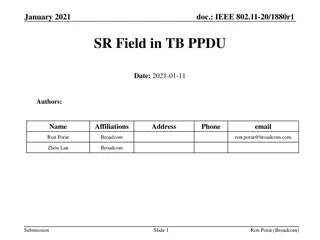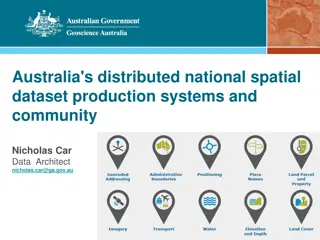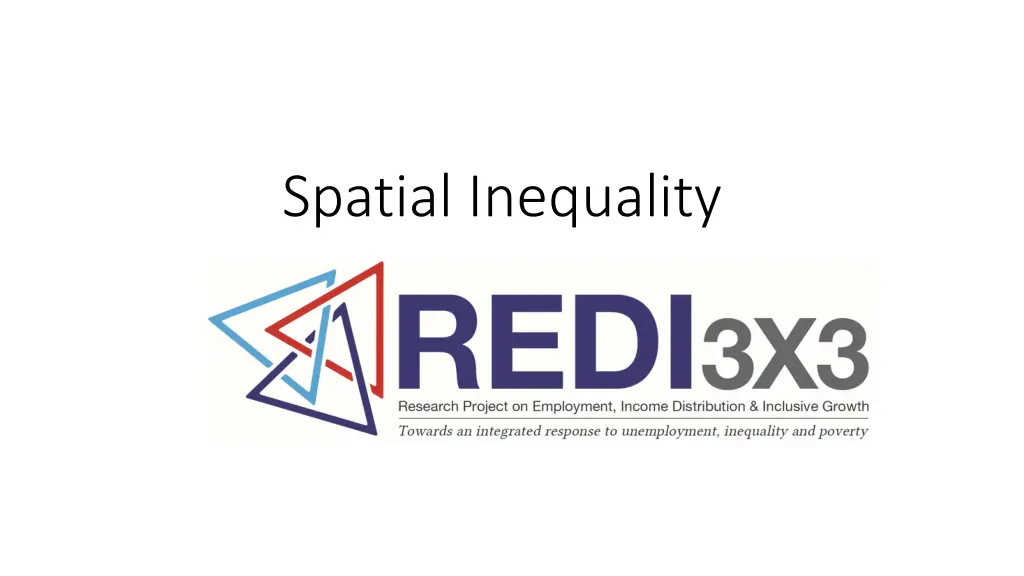
Understanding Spatial Inequality in South Africa
Explore the spatial inequality in South Africa, where the poorest municipalities are predominantly located in the old apartheid homelands. Delve into the challenges faced in rural areas, including issues surrounding land rights, violence, and declining job opportunities in the agricultural sector. Gain insights into the complexities of land reform and redistribution projects and their impact on food security.
Uploaded on | 1 Views
Download Presentation

Please find below an Image/Link to download the presentation.
The content on the website is provided AS IS for your information and personal use only. It may not be sold, licensed, or shared on other websites without obtaining consent from the author. If you encounter any issues during the download, it is possible that the publisher has removed the file from their server.
You are allowed to download the files provided on this website for personal or commercial use, subject to the condition that they are used lawfully. All files are the property of their respective owners.
The content on the website is provided AS IS for your information and personal use only. It may not be sold, licensed, or shared on other websites without obtaining consent from the author.
E N D
Presentation Transcript
Michael Noble and Wanga Zembe of SASPRI have found that the poorest municipalities are, without exception, in the old apartheid homelands, and all except one in either the Eastern Cape or KZN (Ref: Noble, M and Noble, M and Zembe Zembe, W: The geography of inequality, Southern African Social Policy Research Unit , W: The geography of inequality, Southern African Social Policy Research Unit) (Ref:
Spatial Inequality: rural areas Some researchers, such as Aninka Claasens of the Centre for Applied Legal Studies, argue that far from undoing old apartheid laws, some of those that pertain to rural areas in fact reinforce them. Old tenure laws have broken down and an opaque set of land rights has replaced them. More recently, particularly in the North West and KwaZulu- Natal, chiefs have allocated community land for mining rights. People wake up in the morning and find a bulldozer in their yard to prospect, without them consenting. It is not only dispossession, but there are increasing levels of violence in these struggles, and things are made more difficult for rural people because of the chaos in the land administration system. : Aninka Claasens, presentation to REDI3x3 Spatial Inequality policy workshop
Increasing pockets of violence Goodbye Bazooka: Wild Coast anti-mining activist killed GREG NICOLSON
Spatial Inequality: Rural areas In the formal agricultural sector, there has been a massive decline in jobs, driving unemployment and income inequality. 1.5m jobs lost in the formal agriculture sector in the past decade The NDP has a vision of one million new jobs being created in agriculture by 2030 but many researchers ask whether this is realistic Even with land reform programmes, agriculture is a high-risk area to work in: extreme climatic conditions, diseases, environmental factors, and security issues. (Loyiso Ndlovhu, Land Bank, presentation to REDI3x3 workshop)
Spatial Inequality: Rural Areas Land Reform and redistribution projects need to be carefully thought through in terms of issues such as food security About 5 000 out of 35 000 productive enterprises produce most of what we eat, but probably 10 000 farmers produce 60%. (Ben Cousins, PLAAS, UWC) Cousins argues that redistribution should target private agricultural land outside of this. His proposal for land reform is to redistribute 80% of the farms (that we are not dependent on for food security) to the approximately 200 000 market-oriented smallholders in loose value chains. (Cousins, B: Presentation to REDI3x3 workshop)
Spatial Inequality: Policy options A critical policy problem is the fragmented planning and different land tenure policies across rural (and urban) areas. The new Spatial Planning and Land Use Management Act (SPLUMA) aims to correct this, but is some way from implementation. Land reform is a political imperative, but it has to be done in a way that neither destroys food security nor undermines job creation. (Cousins, B)
Spatial Inequality: Urban Areas Reality is that SA is a rapidly urbanising country: 60% of the population now live in urban areas and more than half are under the age of 35 (NDP) Better urban planning policies could boost inclusive growth and reduce inequality, but the country has only been marginally successful Our cities are still sprawling and generally low-density, with the poorest living furthest away from work opportunities. Public transport becomes a key issue in this scenario: black commuters spend on average one third longer than white commuters getting to work and it costs them about 30% of an average hourly wage (Andrew Kerr, DataFirst, presentation to REDI3x3 workshop)
Spatial Inequality: Urban Areas New housing projects tend to be concentrated at the periphery of cities (Ballard, Richard, GCRO, Presentation to REDI3x3 workshop) New plan for mega-cities may exacerbate this spatial inequality. The key policy question is whether it is possible to promote a type of economic self-sufficiency in the proposed new housing areas, or whether they will just compound existing inequalities. Densification is increasing but at an informal level (Ivan Turok,HSRC: Presentation to REDI3x3 workshop) Backyard shack dwellings had increased in Gauteng by 65%, and in Cape Town by 128%. Those living in backyard dwellings are slightly more likely to be employed than those living in RDP houses, but are also less satisfied with living conditions.
Super Size Us: Mega human settlements in Gauteng (Ref: Ballard, R: Presentation to REDI3x3 workshop)
Spatial Inequality: Policy options SA will spend about R182 billion on human settlements and municipal infrastructure this year. (National Treasury, Budget Review, 2016) Of this, about R33 billion will be for settlements either subsidized units, or finance-linked individual subsidies, or upgrading of informal settlements. (Budget Review 2016) The main question is are we getting value for money? This is the question asked by GTAC in its Performance for Expenditure Reviews. In a study of six housing programmes comprising 60% of the budget, GTAC found that RDP houses cost more than the subsidy of R90 000. The average unit is costing government about R253 000. (GTAC, REDI3x3 presentation; figures form 2010/11-2012/13)
Spatial Inequality: Policy Options So what are the alternatives? Densification: SA has provided more than 4 million subsidies and 3 million housing units since 1994, but it has had the paradoxical effect of worsening urban segregation and inequality. (Pieterse, Edgar, African Centre for Cities, Presentation to REDI 3x3 workshop) Pieterse and other urban planners are working on new models of urban development: one is a proposal for a project in Maitland which is central, close to CBD, nearer job opportunities, and provides opportunities for mixed residential space. Whatever the city, or area, Pieterse calls for planning with gees .


